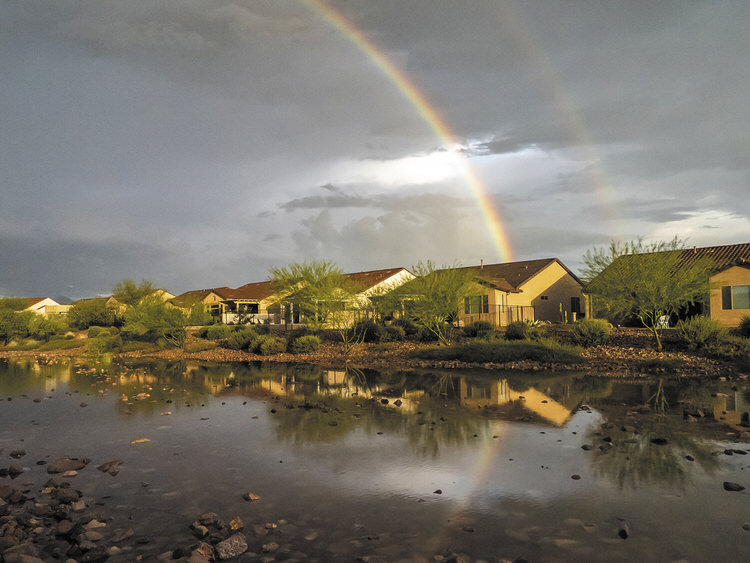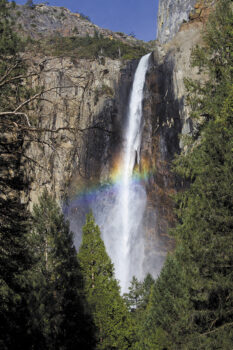
SBR double rainbow (photo by Gerald Tietje)

Fog rainbow (photo by Gerald Tietje)

Bridalveil Fall rainbow (photo by Gerald Tietje)
Gerald Tietje
Noah may have been the first person to see a rainbow, but those of us who live at SaddleBrooke Ranch (SBR) are fortunate to see many rainbows, especially during the monsoon season. We even see some double rainbows! Rainbows are optical illusions, dependent on the location of the observer. For a rainbow to be visible, the sun must be no more than 42 degrees above the horizon; it must be behind the observer; and there must be water droplets in the atmosphere in front of the observer from rain, fog, or spray from a source like a waterfall. The way rainbows are formed is quite fascinating.
The magic occurs inside the water droplets. Think back to high school physics lab when light was passed through a prism to create a spectrum of rainbow colors. Water droplets act like miniature prisms. Our eyes perceive sunlight, a mixture of colors of different wavelengths, as white light. When atmospheric conditions are right, sunlight passes into water droplets and is dispersed into its constituent wavelengths, which are then reflected out of the droplets.
Basically, each color wavelength is refracted (or bent) a different amount as it enters the denser water droplet, separating the light into a band of colors; then the dispersed light is reflected off the back of the droplet and refracted again as it exits the droplet. This happens in millions of droplets at the same time, producing the rainbows we see. Red has the longest wavelength, so it bends the least, and violet has the shortest wavelength and bends the most; this causes red to be at the top of a rainbow and violet to be at the bottom, with colors of intermediate wavelengths in-between. For a double rainbow, the sunlight is reflected twice inside each water droplet. This secondary rainbow forms above the primary rainbow, is fainter, and the bands of color are reversed.
Although I’ve seen many beautiful rainbows during the two years Claire and I have lived at SBR, including double rainbows, I think the most beautiful rainbow I’ve ever seen was in Waimea Canyon, on the Island of Kauai. (Of course, Claire and I were on our honeymoon, so that may have influenced my perception.) On a subsequent anniversary trip to Maui, we saw a fog rainbow; it was white, with just a tinge of red, as sunlight passed through the very small fog droplets. I also remember seeing a stunning rainbow in the spray of Bridalveil Fall one afternoon in Yosemite National Park several years ago. I’ve never seen a moonbow, but a bright moon can also cause a rainbow that looks almost white to the naked eye, but can be captured in full color in a long-exposure photograph.
When monsoonal raindrops start “fallin’ on your heads” later this year, be sure and look for a beautiful rainbow in the sky. I can’t promise any pots of gold, but rainbows are undoubtedly one of nature’s true marvels and should not be missed.
